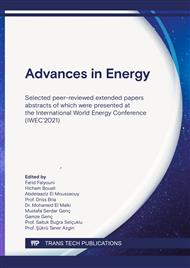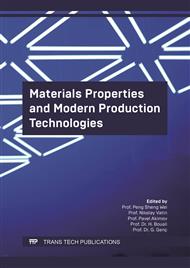[1]
D. B. Xiong, N.L. Okamoto, H. Inui. Enhanced thermoelectric figure of merit in p-type Ag-doped ZnSb nanostructured with Ag3Sb. Scr. Mater., 69 (2013) 397-400.
DOI: 10.1016/j.scriptamat.2013.05.029
Google Scholar
[2]
D. Sidharth, B. Srinivasan, A. A. Nedunchezhian, P. Thirukumaran, M. Arivanandhan, & R. Jayavel. Enhancing the thermoelectric performance of nanostructured ZnSb by heterovalent bismuth substitution. Journal of Physics and Chemistry of Solids, 160 (2022) 110303.
DOI: 10.1016/j.jpcs.2021.110303
Google Scholar
[3]
K. Valset, P.H.M. Bottger, J. Tafto, T.G. Finstad. Thermoelectric properties of Cu doped ZnSb containing Zn3P2 particles. J. Appl. Phys., 111 (2012) 023703.
DOI: 10.1063/1.3675505
Google Scholar
[4]
J. Sottmann, K. Valset, O.B. Karlsen, J. Tafto. Synthesis and measurement of the thermoelectric properties of multiphase composites: ZnSb matrix with Zn4Sb3, Zn3P2, and Cu5Zn8. J. Electron Mater., 42 (2013) 1820-1826.
DOI: 10.1007/s11664-012-2441-7
Google Scholar
[5]
G. J. Snyder, M. Christensen, E. Nishibori, T. Caillat, B. B. Iversen. Disordered zinc in Zn4Sb3 with phonon-glass and electron-crystal thermoelectric properties. Nat. Mater., 3 (2004) 458-463.
DOI: 10.1038/nmat1154
Google Scholar
[6]
G. H. Zhu, W. S. Liu, Y. C. Lan, G. Joshi, H. Wang, G. Chen, Z. F. Ren. The effect of secondary phase on thermoelectric properties of Zn4Sb3 compound. Nano Energy, 2 (2013) 1172-1178.
DOI: 10.1016/j.nanoen.2013.04.010
Google Scholar
[7]
J. B. Li, M. C. Record, J. C. Tedenac. A thermodynamic assessment of the Sb–Zn system. J. Alloys Compd., 438 (2007) 171-177.
DOI: 10.1016/j.jallcom.2006.08.035
Google Scholar
[8]
A. Bafekry, M. Yagmurcukardes, M. Shahrokhi, M. Ghergherehchi, D. Kim & B. Mortazavi. Electro-optical and mechanical properties of Zinc antimonide (ZnSb) monolayer and bilayer: A first-principles study. Applied Surface Science, 540 (2021) 148289.
DOI: 10.1016/j.apsusc.2020.148289
Google Scholar
[9]
M. Gajdos, K. Hummer, G. Kresse, J. Furthmller, F. Bechstedt. Linear optical properties in the projector-augmented wave methodology. Phys. Rev. B: Condens. Matter Mater. Phys., 73 (2006) 045112.
DOI: 10.1103/physrevb.73.045112
Google Scholar
[10]
J. Heyd, G.E. Scuseria. Hybrid functionals based on a screened Coulomb potential. J. Chem. Phys., 121 (3) (2004) 1187-1192.
Google Scholar
[11]
S. Malki, et L. EL Farh. Structural and electronic properties of zinc antimonide ZnSb. Materials Today: Proceedings, 31(2020) S41-S44.
DOI: 10.1016/j.matpr.2020.05.598
Google Scholar
[12]
H. B. Lee, J. H We, H. J. Yang, et al. Thermoelectric properties of screen-printed ZnSb film. Thin Solid Films, 519 (2011) 5441-5443.
DOI: 10.1016/j.tsf.2011.03.031
Google Scholar
[13]
T. Ueda, C. Okamura, Y. Noda, et al. Effect of Tellurium doping on the thermoelectric properties of ZnSb. Materials transactions, 2009, pp.0909070892-0909070892.
DOI: 10.2320/matertrans.m2009201
Google Scholar
[14]
M. Amsler. S. Goedecker. W.G. Zeier et al. ZnSb polymorphs with improved thermoelectric properties. Chemistry of Materials, 28 (2016) 2912-2920.
DOI: 10.1021/acs.chemmater.5b03856
Google Scholar
[15]
K. Niedziolka. R. Pothin. F. Rouessac et al. Theoretical and experimental search for ZnSb-based thermoelectric materials. Journal of Physics: Condensed Matter, 26 (2014) 365401.
DOI: 10.1088/0953-8984/26/36/365401
Google Scholar
[16]
A. Fischer, E.W. Scheidt, W. Scherer, et al. Thermal and vibrational properties of thermoelectric ZnSb: Exploring the origin of low thermal conductivity. Physical Review B,91 (2015) 224309.
DOI: 10.1103/physrevb.91.224309
Google Scholar
[17]
R. Pothin, R.M. Ayral, A. Bercheet al. Preparation and properties of ZnSb thermoelectric material through mechanical-alloying and Spark Plasma Sintering. Chemical Engineering Journal, 299 (2016) 126-134.
DOI: 10.1016/j.cej.2016.04.063
Google Scholar
[18]
Y. Zhang. G. Wang. L. Jin, L. Y. Chen. Y. Chen & X. Shen. Nanostructured ZnSb films composited with Bi2Te3 topological insulators exhibit strongly unusual p–n conduction conversion upon crystallization. Ceramics International.48 (2021) 4539-4544.
DOI: 10.1016/j.ceramint.2021.10.239
Google Scholar
[19]
M. I. Fedorv, L.V. Prokofieva, Yu. I. Ravich, et al. Thermoelectric efficiency of intermetallic compound ZnSb. Semiconductors. 48 (2014) 432-437.
DOI: 10.1134/s1063782614040095
Google Scholar
[20]
L. Bjerg, K.H. Georg KH Madsen, et Bo. B. Iversen. Enhanced thermoelectric properties in zinc antimonides. Chemistry of Materials. 23(2011) 3907-3914.
DOI: 10.1021/cm201271d
Google Scholar
[21]
A.Berche, Alexandre et Jund, Philippe. Thermoelectric power factor of pure and doped ZnSb via DFT based defect calculations. Physical Chemistry Chemical Physics. 21 (2019) 23056-23064.
DOI: 10.1039/c9cp04397g
Google Scholar
[22]
D. Eklof, A. Fischer, Y. Wu et al. Transport properties of the II–V semiconductor ZnSb. Journal of Materials Chemistry A. 1(2013) 1407-1414.
Google Scholar
[23]
P. Blaha, K. Schwarz, P. Sorantin, et al. Full-potential, linearized augmented plane wave programs for crystalline systems. Computer physics communications. 59 (1990) 399-415.
DOI: 10.1016/0010-4655(90)90187-6
Google Scholar
[24]
P. Hohenberg, W. Kohn. Inhomogeneous electron gas. Physical review. 136 (1964) B864.
DOI: 10.1103/physrev.136.b864
Google Scholar
[25]
F. Tran et P. Blaha. Accurate band gaps of semiconductors and insulators with a semilocal exchange-correlation potential. Physical review letters, 102(2009) 226401.
DOI: 10.1103/physrevlett.102.226401
Google Scholar
[26]
C. Ambrosch-Draxl and J.O. Sofo. Linear optical properties of solids within the fullpotential linearized augmented planewave method. Computer physics communications 175 (2008) 1-14.
DOI: 10.1016/j.cpc.2006.03.005
Google Scholar
[27]
F. Wooten. Optical Properties of Solids", New York: University of California, Academic Press.(1972).
Google Scholar
[28]
D. R. Penn. Wave-number-dependent dielectric function of semiconductors. Physical Review,. 128 (1962) (2093).
DOI: 10.1103/physrev.128.2093
Google Scholar
[29]
B. Merabet, H. Aalami, A. ZaouiI, et al. Ab initio LSDA+ U Study of Optical Properties of RVO4 (R= Eu, Ho, Lu) Compounds. Materials Research, 21 (2018).
DOI: 10.1590/1980-5373-mr-2016-0568
Google Scholar
[30]
B. Amina, A. Lachebi, A. Shuhaimi, et al. First-principles calculation of structural, optoelectronic properties of the cubic AlxGayIn1-xy N quaternary alloys matching on AlN substrate, within modified Becke–Johnson (mBJ) exchange potential. Optik. 127 (2016) 11577-11587.
DOI: 10.1016/j.ijleo.2016.09.014
Google Scholar
[31]
M. Faizan, M., Murtaza, G., Azam, Sikander, et al. Elastic and optoelectronic properties of novel Ag3AuSe2 and Ag3AuTe2 semiconductors. Materials Science in Semiconductor Processing, 52 (2016) 8-15.
DOI: 10.1016/j.mssp.2016.05.009
Google Scholar



